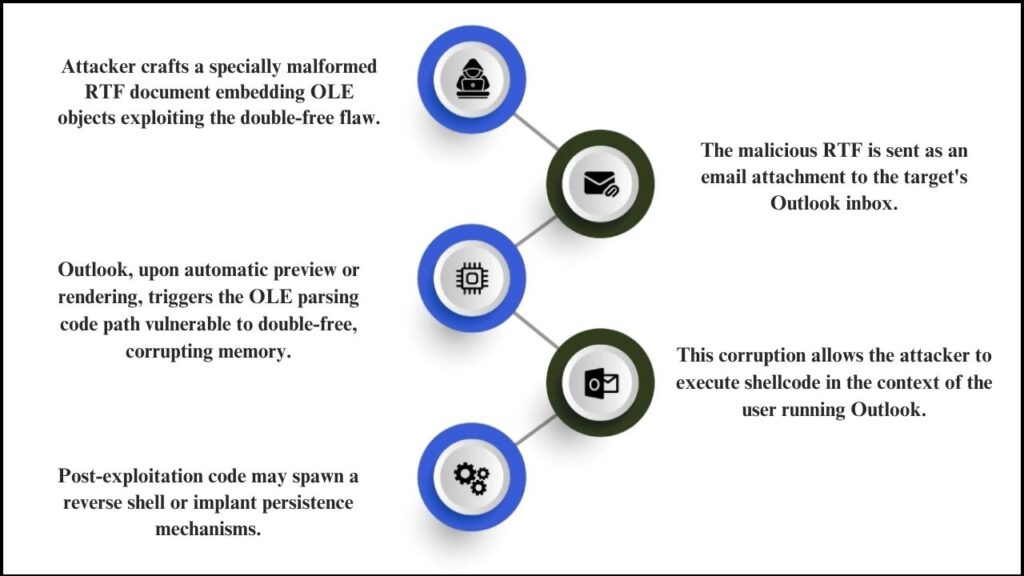Microsoft has disclosed a critical security vulnerability, CVE-2025-53786, that affects hybrid deployments of Microsoft Exchange Server 2016, 2019, and Subscription Edition. This flaw allows hackers who have administrative access to an on-premises Exchange server to escalate privileges and gain control over the connected cloud environment, including Exchange Online. This could result in a total domain compromise of an organization’s infrastructure. Given its high severity and far-reaching impact, cybersecurity agencies such as the U.S. Cybersecurity and Infrastructure Security Agency (CISA) have issued urgent alerts demanding immediate action.

This article explains this vulnerability clearly, providing context, practical advice, and detailed steps for organizations to protect themselves. It is written in a friendly, easy-to-understand style while giving valuable insights for IT professionals.
Table of Contents
New Exchange Bug Could Let Hackers Take Over Entire Domains
| Key Aspect | Details |
|---|---|
| Vulnerability ID | CVE-2025-53786 |
| Severity | High (CVSS score: 8.0 / 10) |
| Affected Products | Microsoft Exchange Server 2016, 2019, Subscription Edition in hybrid deployments |
| Risk | Privilege escalation leading to full domain takeover, including Exchange Online access |
| Prerequisite for Attack | Attacker must already have administrative access to on-premises Exchange server |
| Mitigation | Apply April 2025 hotfix; deploy dedicated Exchange hybrid apps; reset service principal credentials |
| CISA Directive Deadline | August 11, 2025, 9 a.m. EDT for U.S. Federal Civilian Executive Branch agencies |
| Official Guidance | Microsoft Security Update Guide |
The CVE-2025-53786 vulnerability represents a critical security risk for organizations relying on hybrid Microsoft Exchange Server environments. It allows attackers with administrative access on-premises to silently compromise cloud environments, including Exchange Online, potentially leading to a complete domain takeover.
By promptly applying Microsoft’s April 2025 hotfix, deploying dedicated Exchange hybrid applications, resetting legacy credentials where relevant, and enforcing strong security practices like MFA, organizations can significantly reduce the risk of exploitation.
Swift and informed action is essential to protect your critical communication infrastructure from potentially devastating cyberattacks.
What Exactly Is This Microsoft Exchange Vulnerability?
The CVE-2025-53786 vulnerability targets organizations with hybrid Microsoft Exchange setups—meaning their email systems combine both on-premises Exchange servers and cloud-based Exchange Online services.
In these hybrid configurations, on-premises Exchange servers and Exchange Online share a “service principal,” which acts like a shared identity or key that lets them authenticate and interact securely. This setup was designed for smooth integration, like calendar sharing and mail flow between on-premises and cloud mailboxes.
However, this shared identity creates a security weakness: if an attacker already has administrator access to an on-premises Exchange server, they can exploit this flaw to silently escalate privileges into the cloud environment. They can:
- Modify user passwords
- Convert cloud-only users to hybrid users
- Impersonate users inside the hybrid deployment
- Retain access undetected for up to 24 hours using tokens that cannot be revoked remotely
This vulnerability presents severe risk because the attack leaves almost no detectable audit trail, making it very difficult for organizations to notice an intrusion.
Why Should Organizations Take This Seriously?

Microsoft Exchange is a core service in many enterprises, handling essential email and collaboration needs. This vulnerability jeopardizes:
- Confidentiality: Attackers could access sensitive emails and data.
- Integrity: They can change user permissions or compromise accounts.
- Availability: They might disrupt services by taking over administrative controls.
Attackers who exploit this flaw could effectively control an entire organization’s domain, moving between on-premises and cloud systems seamlessly, and establish persistent backdoors.
Because this vulnerability operates at the identity and authentication layer, it’s especially critical: attackers can impersonate executives or IT staff and bypass many traditional security protections.
The U.S. Cybersecurity and Infrastructure Security Agency (CISA) has prioritized this threat, issuing an emergency directive requiring federal agencies to patch by August 11, 2025. The wider cybersecurity community considers this vulnerability high-risk for all organizations using Exchange hybrid deployments.
How Does This Vulnerability Work? A Simple Analogy
Think of your hybrid Exchange setup as a shared office building with two connected sections: the on-premises part (physical office) and the cloud part (remote office). The shared service principal is like a master key that opens doors between these two sections.
If a malicious person gains access inside the physical office and steals that master key, they can walk into the cloud office freely without anyone noticing. This stolen master key allows them to impersonate anyone, access files, and move around silently.
Moreover, this “key” comes in the form of special access tokens valid for 24 hours, and these tokens cannot be cancelled remotely, giving attackers a full day of uninterrupted and invisible access.
Protective Measures: Step-by-Step Guidance for Organizations
Fortunately, Microsoft has released patches and clear guidance to help organizations secure their Exchange environments. Here’s what needs to be done promptly:
- Apply April 2025 Hotfixes or Later Updates
Microsoft quietly released an important hotfix on April 18, 2025, which fixes the vulnerability incidentally. Organizations must ensure they have installed this update or any newer cumulative updates for their on-premises Exchange servers. - Deploy Dedicated Exchange Hybrid Applications
In response to this flaw, Microsoft is moving away from using the shared service principal to dedicated Exchange hybrid applications. These dedicated apps give separate identities to cloud and on-premises services, effectively eliminating the shared-key weakness. Administrators should follow Microsoft’s detailed configuration instructions to deploy and validate these dedicated hybrid apps. - Reset Service Principal Credentials if No Longer Using Hybrid/OAuth
If your organization enabled OAuth or hybrid connectivity in the past but no longer uses it, reset the service principal’s keyCredentials to invalidate any potentially compromised tokens. - Regularly Use the Exchange Health Checker Tool
Microsoft offers the Exchange Health Checker tool, which audits the Exchange environment for known issues, including this vulnerability. Running this tool helps identify vulnerabilities early and guides remediation. - Follow Best Cybersecurity Practices
- Limit administrative Exchange access as strictly as possible.
- Enforce multi-factor authentication (MFA) for all Exchange administrators.
- Monitor Exchange and cloud logs regularly for suspicious behavior, even though this flaw minimizes audit logs.
- Segment your network to isolate critical Exchange infrastructure.
- Educate IT teams about potential attack paths and keep up with security updates.
Timeline and Ongoing Response
- April 18, 2025: Microsoft quietly released the hotfix that addresses this vulnerability.
- August 6, 2025: Microsoft officially disclosed CVE-2025-53786 following a security researcher’s detailed presentation.
- August 7, 2025: CISA issued Emergency Directive 25-02, mandating federal agencies to patch by August 11.
- By October 2025: Microsoft plans to enforce dedicated Exchange hybrid applications exclusively and temporarily block Exchange Web Services (EWS) traffic linked to the vulnerable shared principal.
This rapid response highlights the seriousness of the threat and the need for organizations to act immediately.
Google’s AI Bug Hunter Just Uncovered 20 Shocking Security Flaws
Two Top AI Coding Tools Just Wiped Out User Data — What Went Terribly Wrong
Google Search in 2025: The Complete Guide to How AI Is Redefining Information Discovery
FAQs About New Exchange Bug Could Let Hackers Take Over Entire Domains
Q1: Who is affected by this vulnerability?
Organizations that use Microsoft Exchange Server 2016, 2019, or Subscription Edition in a hybrid configuration with Exchange Online are affected if they have not applied the April 2025 patches or deployed dedicated hybrid apps.
Q2: Can this vulnerability affect users without admin access?
Initial exploitation requires admin-level access to the on-premises Exchange server. However, once compromised, attackers can impersonate any user and access their data.
Q3: Has this flaw been exploited in the wild?
As of now, no active exploits have been reported in the wild, although proof-of-concept attacks have been demonstrated by security researchers.
Q4: What if my Exchange deployment is fully on-premises or fully cloud-based?
This vulnerability only affects hybrid deployments where Exchange Server is integrated with Exchange Online. Fully on-premises or fully cloud-based setups without hybrid use are not vulnerable.
Q5: How can I verify if my servers are patched?
Use the Exchange Health Checker tool and verify that the servers are updated with the April 2025 hotfix or later cumulative updates.
Q6: What is a service principal in this context?
A service principal is an identity used for service-to-service authentication between Exchange on-premises and Exchange Online in hybrid deployments. Previously, a shared service principal was used, which created this vulnerability.



















